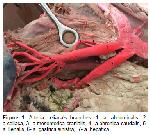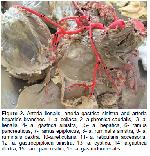It was observed that aorta abdominalis passed from cavum thoracis to cavum abdominis through hiatus aorticus. It was determined that arteria celiaca, which was the first branch in cavum abdominis, was progressing towards the ventral at the first lumbar vertebra level. It was observed that the first vessel that left the arteria celiaca. Later, it was determined that arteria lienalis and arteria hepatica and arteria gastrica sinistra took origin as a common root, respectively (Figure
1).

Büyütmek İçin Tıklayın |
Figure 1: Arteria celiacas branches. 1- a. abdominalis, 2- a.celiaca, 3- a.mesenterica cranialis, 4- a.phrenica caudalis, 5- a. lienalis, 6- a. gastrica sinistra, 7- a. hepatica. |
Arteria lienalis: Arteria lienalis first gave the ramie pancreatici to the pancreas. It was later determined that he gave ramus epiploicus and arteria ruminalis sinistra, which fed the omentum majus during the course of the vessel. After giving arteria ruminalis dextra, it continued its course as arteria lienalis (Figure 1, 2).

Büyütmek İçin Tıklayın |
Figure 2: Arteria lienalis, arteria gastrica sinistra and arteria hepatic's branches. 1- a. celiaca, 2- a.phrenica caudalis, 3- a. lienalis, 4- a. gastrica sinistra, 5- a. hepatica, 6- ramus pancreaticus, 7- ramus epiploicus, 8- a. ruminalis sinistra, 9- a. ruminalis dextra, 10-a.reticularis, 11- a. reticularis accessoria, 12- a. gastroepiploica sinistra, 13- a. cystica, 14- a.gastrica dextra, 15- rami pancreatici, 16- a. gastroduodenalis. |
Arteria ruminalis sinistra: Arteria ruminalis sinistra originated from the left side of arteria lienalis. It was observed that the artery reached the right side of the atrium ruminis by running caudoventrally. Afterwards, it was determined that vascularize the parietal face of saccus cecus craniodorsalis and saccus cecus cranioventralis (Figure 1, 2).
Arteria ruminalis dextra: It was determined that Arteria ruminalis dextra (Figure 1, 2) originated from the right side of the arteria lienalis and reached the visceral face of the rumen with a caudoventral course. It was observed that the arteria ruminalis dexter, which hovers within the sulcus longitudinalis dexter, was extended to the sulcus caudalis and ended in this groove passing to the parietal face of the rumen. During the course of a. ruminalis dextra, it was observed that this vessel gave coronary arteries vascularizing the saccus cecus on the parietal and visceral face.
Arteria hepatica: Arteria hepatica was originated from arteria celiaca as a common root with arteria gastrica sinistra. It was determined that the vessel progressed towards porta hepatis in the visceral aspect of liver and continued to progress as arteria gastroduodenalis after giving vessels named arteria cystica, arteria gastrica dextra and rami pancreatici (Figure 2). It was determined that arteria gastroduodenalis was named as arteria gastroepiploica dextra after giving arteria pancreaticoduodenalis cranialis and it anastomosed with arteria gastroepiploica sinistra in the curvatura minor of abomasum.
Arteria cystica: After leaving arteria hepatica, it was determined that the arteria cystica, which travels on the visceral side of the liver, was distributed to vesica fellea (Figure 2).
Arteria gastrica dextra: It was determined that the arteria gastrica dextra (Figure 2), which was on the visceral side of the liver, gave the arteria lobi caudati for the caudal lobe of the liver and then anastomosed with arteria gastrica sinistra.
Arteria gastroduodenalis: Arteria gastroduodenalis, seen as the continuation of arteria hepatica, continued as arteria gastroepiploica dextra on the curvatura major of abomasum, and it gave the arteria pancreaticoduodenalis cranialis (Figure 2). It was determined that Arteria gastroepiploica dextra was ended by anastomosis with arteria gastroepiploica sinistra and vascularized the curvatura major and omentum majus during the course of the vessel.
Arteria pancreaticoduodenalis cranialis: Arteria pancreaticoduodenalis cranialis (Figure 2), originating from arteria gastroduodenalis, gave branches feeding pancreas and pars cranialis dudodeni.
Arteria gastrica sinistra, originating from arteria celiaca as a common root with arteria hepatica, was the continuation of the vessel. It was noteworthy as the thickest branch of arteria celiaca. During the course of the vessel, it gave first arteria reticularis, arteria gastroepiploica sinistra and arteria reticularis accessoria in the area between omasum and reticulum. Then, it was determined that continued its course by giving left and right branches on visceral face of omasum (Figure 2). It was ended by anastomosis with arteria gastrica dextra on the curvatura minor of abomasum.
Arteria reticularis: Arteria reticularis (Figure 2), originating from arteria gastrica sinistra, in the sulcus reticuloruminalis it gave branches named ramus ruminalis and ramus reticularis.
Arteria gastroepiploica sinistra: Arteria gastroepiploica sinistra (Figure 2), originating from the arteria gastrica sinistra on the atrium ruminis, cranioventrally, passed through the sulcus reticulo-omasi and anastomosed with the arteria gastroepiploica dextra on the curvatura major and the omentum majus. It has been determined that it gave branches to reticulum, omasum and abomasum.
Arteria reticularis accessoria: Arteria reticularis accessoria originating from arteria gastrica sinistra, immediately after the arteria gastroepiploica sinistra (Figure 2), gave a number of branches on the visceral face of the reticulum and the parietal face of omasum.




